A. Lange & Söhne 1815 Chronograph Boutique Edition – Full Review with tons of Photos, Specs and Price

The A. Lange & Söhne 1815 Chronograph Boutique Edition is yet another example of the superlative chronographs, developed by the Haute Horlogerie brand from Glashütte, Germany. We were recently given the opportunity to test and wear the watch for a couple of weeks. To cut a long story short: we loved it. As we have already introduced the watch to you, in this article we will focus mainly on the chronograph movement, more specifically its characteristics, what distinguishes it from other chronograph movements, and how it actually works. It looks great, yes, but what is what, and what does what? What is the purpose of all those wheels, levers, bridges and springs? Read on to learn how a chronograph actually works.
The Lange 1815
The 1815 family of watches is one of the 5 families of the A. Lange & Söhne collection. The name stands for the year of birth of Ferdinand A. Lange, the founder of the original A. Lange & Söhne company and the inspirator of the new company, as it was relaunched in 1993. The 1815 family of watches has been part of the Lange collection since 2002, and every model shares the same design characteristics: clean dial, Arabic numerals and a railway-track minute scale.
We’ll start this article with a concise review of the 1815 Chronograph Boutique Edition’s specifics, followed by an explanation of chronographs, and then we come to a detailed deconstruction of the 1815 Chronograph’s movement and exactly how it all works.
Case and Dial of the A. Lange & Söhne 1815 Chronograph Boutique Edition
Lange has always spoiled us with perfectly designed and finished dials and cases. The Lange 1815 Chronograph Boutique Edition was launched as a tribute for the 200th birthday of F. A. Lange, and in that respect no compromises have been made. The design goes back to the first edition of the 1815 Chronograph, and that means a re-introduction of the pulsation scale. The pulsation scale is used to measure your or another person’s heart rate, or actually any other beat or rate. The rate per minute can be read on the scale after 30 pulsations have been counted.
The solid silver dial has multiple layers giving it a nice depth, thick blue numerals (as if ink was dropped on the dial), white golden hour and minute hands and blued steel hands for the chronograph and small seconds. In sunlight especially, the dial shines and looking at it is a sheer bliss. The dial is very legible, functional and balanced. This style of chronographs, with pulsometers, was used by doctors, and legibility is a must when you are measuring someone’s heart-rate.
The brand’s name is on the inclined ring, in between the numerals of the pulsometer, and left to it is ‘Graduated for 30 pulsations’. In the dial’s centre are the words ‘Flyback’ and below that is ‘Chronograph’, and these two lines of text actually balance the dial as a whole. As to be expected, the white gold case is very well finished, with partly brushed and partly polished parts, and lovely beveled edges.
The case size of 39.5mm in diameter (without crown or pushers) and 11.0mm in height makes it sit comfortable on the wrist without shifting to the side. On an average size wrist it sits nicely balanced, and also shows a bit of the matching-colour strap. That strap is a hand-stitched, dark blue, alligator leather strap, with large scales, and it’s closed with a white-gold tang buckle (ardillon in French) in a quality that we know from the company.
More about Chronographs
Monochrome founder and owner Frank Geelen has been saying it for a long time: a chronograph movement is one of the most difficult complications around. The often praised tourbillon for instance, is easier to conceptualize than a chronograph. The forces inside the movement, and the many fluctuation of forces, is incredibly difficult to manage. Designing a good chronograph requires a thorough knowledge of mechanical movements to do it “right”. It seems straightforward: the device needs to start and stop reliably, and upon reset the counters need to jump back swiftly to their zero position. But you’ll find out, after reading this article, that it is anything but simple.
Pushing the buttons… In actuation the chronograph’s functions, the pushers need just enough resistance to start the time measurement at the right time. It might sound easy, but just try several chronographs and really feel and try the pushers. When operating the Lange 1815 Chronograph you will feel the smooth yet firm click, every time you actuate the chronograph’s functions. This is how a good great chronograph feels.
What is a chronograph? A chronograph is a timepiece that combines the functionality of a conventional watch, i.e. time telling, with the functionality of a stopwatch, i.e. measuring a time interval, into one watch.
Number of pushers? Most modern chronographs are double-pusher chronographs, meaning that two buttons are used for time interval measurement. One pusher to start and stop the chronograph, and the other pusher to reset all chronograph counters to zero. There are also mono-pusher or single-pusher chronographs and these combine all functions into one pusher. In French these are called mono-poussoir chronographs, and many aficionados also use this French term.
Some chronographs have not one, not two, but three pushers. This is the split-second or rattrapante chronograph or double-chronograph. Yes, there are many different words but they are one and the same, and all these terms are actually used. Anyways, the split-second chronograph has a third button – mostly positioned at the 8 o’clock or 10 o’clock position, or inside the crown – to stop one of the chronograph hands while the other hand continues to move and thus record a time interval. A second press, on that third pusher, causes the stopped hand to align again with the running hand.
Chronograph scales: Often chronographs show one or more of the following scales (links go to Wikipedia):
- Tachymeter – enables the measurement of speed
- Telemeter – enables the measurement of distance
- Pulsometer – enables the measurement of the pulse rate
The scales of the Lange 1815 Chronograph Boutique Edition, including a pulsation scale
Now the mechanics, because here’s more than scales on a dial, and pushers in the case band. A chronograph comprises all movement parts that are required for the ‘time telling’ like the main spring, gear train, main plate, bridges, and escapement, however there are also three groups of components needed for operating the chronograph:
- A coupling (clutch) system that transfers the power and rate of the going train to the chronograph.
- A control (operating) system for starting, stopping and resetting the chronograph:
- The column wheel (or cam) engages the counter system by releasing the brake from the central chronograph wheel and by engaging the coupling system.
- The start/stop operating mechanism triggers the start by engaging the column wheel and the stop by engaging the hammer and the brake.
- The reset mechanism triggers the return of the counters to zero. A flyback mechanism ensures that the chronograph starts running immediately after the reset-to-zero.
- The hammer is involved in returning the counters to zero and activates the brake.
- The brake prevents the chronograph hand from moving when it is supposed to rest.
- Counter (runner) systems for seconds, minutes and possibly hours. The L951.5 movement has counters for seconds and minutes. Each has a heartcam and a long pivot that extends through the movement to the dial. To each pivot a hand is fitted for the recording of seconds and minutes (and hours, if applicable).
The three systems of a chronograph, in this case the L951.5 movement
Each system comprises multiple parts:
For reference purposes: the parts involved in operating the chronograph
The Movement of the A. Lange & Söhne 1815 Chronograph Boutique Edition
“In awe” are the words that springs to mind when you look at the gorgeous L951.5 movement of the 1815 Chronograph. Movement design and development requires great skills and large investments. Therefore it is no wonder that many watch companies turn to specialists for adding chronograph modules to their movements or buying complete chronograph movements. Lange does not do that. The calibre L951.1 (first introduced in the iconic Datograph) was shown to the world in 1999 was designed and developed from the ground up. This manually wound movement did set new standards for high quality chronographs.
The reference number: The ’95’ refers to the year the development of the movement started. The .1 refers to the incremental improvement made within the first generation that is represented by the “1’ following the “95” (source: 1). All L951.x movements are horizontal clutch chronographs with column wheel, instantaneous jumping minutes and a flyback function.
A symphony of curves and shapes in the L951.5 movement
The A. Lange & Söhne 1815 Chronograph Boutique Edition houses the calibre L951.5, i.e. the fifth iteration of the movement. Key characteristics of this movement compared to other generations of the L951 movement are:
- The operating lever spring in this calibre version is mounted on the lever itself, which pushes a pin fixed at the chronograph baseplate (it was the other way around in the L951.1). The baseplate and levers have also been changed subtlety.
- It uses the in-house balance wheel. While the older generations use the balance wheel with timing screws and a swan-neck regulator, this generation has a balance wheel with six (6) eccentric weights for poising. It is a free-sprung balance, meaning that the rate is adjusted by moving the weights away from the center or towards the center, which influences the inertia of the balance itself. A free-sprung balance has a fixed-length hairspring while a regulated balance has a variable-length hairspring (which is change by moving the index on the balance cock, causing a pair of curb pins to slide along the hairspring, resulting in a shorter or longer hairspring. The advantage of a free-sprung system is rate stability and better inherent positional accuracy as it enables concentric breathing of the hairspring. However, the system is more difficult to regulate.
- It features a larger mainspring barrel and improved gear teeth to enable a longer power reserve of 60 hours.
A key characteristic of the L951.5 movement: the operating lever spring fixed on the operating lever (towards the top and above the minute counter bridge)
Chronograph movements do not only vary in design. They also vary in solutions for implementing the control, coupling, and counter systems. The most important variations are:
A vertical vs horizontal coupling clutch system: The horizontal coupling is the traditional and more delicate and aesthetically appealing approach to couple the gear train with the chronograph. In a vertical clutch system, an oscillating pinion that is connected to the second wheel is used to engage or disengage the chronograph wheel. The coupling mechanism is positioned vertically, hence the name. The theoretical advantage of a vertical clutch is that there are no teeth involved that could need a fraction of a second before the gear teeth have meshed properly, and thus cause a small jump of the second hand and additional wear and tear of the teeth.
The L951.5 movement has a horizontal coupling system, consisting of a mounting component, a driving/transmission wheel that connects to the fourth wheel of the going train, an intermediate wheel that connects to the seconds counter system, and a lever that connects to the control system (more specifically, the column wheel).
Horizontal coupling system of the L951.5 movement
Flyback vs stop/reset in resetting the chronograph: In a regular chronograph the reset button cannot be pushed when the hands are moving because a beak of the hammer would hit against one of the pillars of the engaging mechanism (for example column wheel – also referred to as pillar wheel – or the heartpiece limiter of the Valjoux). The hammer of the L951.x movement lacks such a beak and has a separate flyback mechanism.
Flyback mechanism of the L951.5 movement
Column wheel vs cam-based engaging system: A column-wheel based chronograph is more traditional, delicate (vulnerable), more labor-intensive and difficult to produce. A cam-actuated system is easier to produce and maintain, cheaper, and more robust. The performance is comparable, although column-wheel based systems may lead to a smoother use of the hands (no noticeable jerks, precise start and stop), especially when combined with a vertical coupling clutch. Note: Although the L951 movements have a horizontal clutch, the performance is very smooth.
Column wheel of the L951.5 movement
The mounting of the transmission or driving wheel: In a conventional chronograph the transmission wheel is mounted on the fourth (seconds) wheel of the gear train after assembly of the train. This may result in bending the shaft or an irregularly rotating transmission wheel. In the Lange L951 movements, the seconds-wheel and the transmission-wheel are fixed to the same shaft pivoted under a separate seconds-wheel bridge. This ensures a level and constant drive.
Transmission (and intermediate) wheel of the L951.5 movement
Integrated vs modular chronographs: The integrated chronograph was designed to be a chronograph movement from the start; all components are “built-in”. A modular chronograph adds a chronograph module to a base calibre. Dubois-Dépraz are one of a few companies that design and manufacture chronograph modules for other watch companies.
See for more information about variations our article Technical Perspective about Chronographs.
Above: detailed view of the coupling clutch, the column wheel, the flyback mechanism and the central chronograph wheel of the L951.5 movement. Notice the hook of the operating lever and the fingers of the coupling clutch that mount to the column wheel and the flyback mechanism.
Below: a detailed 3D view of the coupling clutch, the column wheel, and the central chronograph wheel the L951.5 movement. Note the heartpiece under the central seconds bridge that plays a key role in resetting the chronograph:
What distinguishes the Lange chronograph movement from other high-quality chronograph movements?
While the Valjoux 7750 movement may well be the industry standard for reliable, functional chronographs (e.g. see Walter Odet’s article on Timezone), high-end chronographs add another component: designs that make your heart sing (check the first two paragraphs of Frank’s review of the Lange Double Split). The curves and shapes of the high-end chronograph parts look like a 3D-landscape where most parts can be looked at. The design is almost a symphony: everything breathes harmony and alignment, while each part serves its own purpose, much like an orchestra.
As said, it takes quite an investment to develop a high-end manual chronograph movement and that may explain why most contemporary high-end chronographs of Patek Philippe, Vacheron Constantin and others were developed after the introduction and success of the Datograph in 1999. For this reason alone, the Datograph from 1999 deserves the qualifications “icon” and “legend”.
3D view on the L951.5 movement
While most high-end chronograph movements are beautifully designed, the finishing of the movement puts Lange in a different league compared to most others. We could marvel about the finishing for an hour. Every single part is polished or brushed by hand on both sides. Especially the hand-polishing of the sharp inner angles cannot be achieved by a machine. It is a time-consuming process and requires great skill. Compare a Lange movement with any other movement and you will marvel about the incredible finishing skills of the people at Lange.
The superb finishing of all components: bridges, wheels, levers, and escapement of the L951.5 movement
How does the Lange 1815 Chronograph L951.5 movement work?
What happens when the chronograph is initiated?
Before the recording of a time interval starts, the seconds and minute hands are at the zero position, and the end (Be) of the brake lever (B) rests against the rim of the (seconds) chronograph wheel (SW). When the start/stop button (at 2 o’clock; ) is pressed, operating lever (O) is activated. Through its pawl (Op – the hook) column wheel (CW) is turned the required distance. This mounts a column (or pillar) of the column wheel to beak (Bb) of the brake lever, and that raises end (Be) of the brake lever from the central seconds chronograph wheel SW. Simultaneously the shift of the column wheel causes beak (Cb) of the coupling clutch (CC) to drop between two columns of the column wheel, allowing the intermediate wheel (IW) to engage with the central seconds chronograph wheel (SW). The chronograph now starts to run because the intermediate wheel is connected to the fourth wheel of the going train (i.e. the seconds wheel) via driving wheel (TW).
Overview of the components involved (coding as included in text in alphabetical order)
Instantaneous minutes counting required fitting a small snail cam on the arbor of the central seconds chronograph wheel. When the central seconds chronograph wheel rotates to the right point, the sliding stone (visible at the northwest part of the chronograph wheel in the graphic) on the minutes-counter lever (M) drops off the edge of the snail cam, making the hook (Mh) to pull the minutes-counter (MW) one-step forward. The mounting of the snail cam and the heartpiece (Shp) have such close tolerances, that the position of the stone engaging the snail has been made adjustable. This allows for fine adjustment to be made, after the entire mechanism has been assembled. A patent was registered for this.
Note: the common approach is to use an intermediate wheel that is pulled one tooth at a time by a finger on the chronograph wheel. This intermediate wheel gears with the minute wheel. When the hammer returns the recording to zero,
What happens when you stop the timing?
Pressing the start/stop button (at 2 o’clock) again causes the beak (Cb) of the coupling clutch to mount a column of the column wheel and the hand stops. At the same moment beak (Bb) of the brake lever (B) drops between two columns of the column wheel permitting the opposite end (Be) to rest against the rim of the chronograph wheel. There is no need to stop the minute counter because it is not driven by the gear train or other wheels; the minute counter wheel is only moved forwards when hook (Mh), which is fixed to the Minute Counter Lever (M), engages a tooth of the Minute Counter Wheel (MW) that causes the wheel to move, as described above.
What happens when you reset the chronograph function?
The hands are returned to zero by pressing the reset button at 4 o’clock. When this button is pressed, lever (R) (below depresses hammer lever H, via peg Rp), so that the peg at (Fp) slides along the curve of flyback lever (M). The flyback lever acts on a finger of the clutch lever (CC) to disengage the clutch-wheel (IW) while hammer lever (H) falls on the heart-piece (Shp) to bring the central chronograph wheel (SW) and its hand to zero.
At the same time, piece (Mr) which is under the fly-back lever lifts the hook (Mh) from the wheel of the minutes counter (MW). The minutes counter lever (M) drops off the edge of a snail cam, to zero the chronograph minutes, as well for synchronization restart with the chronograph seconds.
When the button is released, the process is reversed and the chronograph hand restarts instantly from zero as the connection between the clutch wheel (IW) and the chronograph wheel (SW) is restored.
Overview of the components involved (coding as included in text in alphabetical order)
Note: a standard method is that the hammer shifts the column wheel which in turn lifts the brake lever, which releases the chronograph runner. Another hammer beak wedges into sliding gear to cut out the minute’s runner out of action. The flat hammer faces (ends) impinge the heart cams of the runners and the recording-hands are returned to zero. When the reset button is released the hammer is returned to its position of rest by the hammer spring. The return to zero of the minutes hand is attended by the action of a jumper instead of entirely the hammer.
Springs have not been mentioned yet. The role of a spring is to provide force to hold a lever in its position. The important springs of the L951.5 movement are shown in this graphic:
Conclusion
While the 1815 chronograph is known as the entry-level chronograph of the Saxon Manufacture, it is far from that. Basically, you have a Datograph in a thinner and cleaner package, without date and power reserve, for €20K less. The watch is superbly finished (like every Lange), runs smoothly, and has a very useful pulsometer function. Whether that justifies the price tag of € 49,000 Euro is up to you.
We love the Lange 1815 Chronograph Boutique Edition! It’s as simple as that. The combination of white-silver dial, blue hands, blue alligator strap as well as the re-introduction of the pulsometer, makes the watch different enough from other Lange chronograph watches to justify the purchase, also when you own a Datograph or Double Split. The watch works well on both a women’s and a man’s wrist.
Word of gratitude…
Thanks to Max, for checking all technical descriptions. And a special thanks to Frank, for improving the article.
Specifications A. Lange & Söhne 1815 Chronograph Boutique Edition
Reference: 414.026
- Case: 18k white gold – Diameter: 39.5 millimeters; height: 11.0 millimeters
- Dial: Hours and minutes hands in rhodiumed white gold; seconds, chronometer sweep seconds and minute counter in blued steel
- Functions: Time indicated in hours, minutes and subsidiary seconds with stop seconds; flyback chronograph with precisely jumping minute counter; pulsometer scale
- Movement: Lange manufacture calibre L951.5; manually wound, decorated and assembled by hand; precision-adjusted in five positions; plates and bridges made of untreated German silver; balance cock engraved by hand; 306 parts; 34 jewels (including 4 in screwed gold chatons); lever escapement; Shock-resistant balance wheel with eccentric poising weights; balance spring manufactured in-house with a frequency of 18,000 semi-oscillations per hour, precision beat-adjustment system with lateral set screw and whiplash spring; power reserve of 60 hours; Diameter: 30.6 millimeters; height: 6.1 millimeters;
- Strap and buckle: Hand-stitched alligator leather strap, dark blue, white-gold prong buckle
- Price: € 49,000 Euro (incl. taxes) – exclusively available in the official boutiques of the brand
More details van be found HERE at the Lange & Söhne website.
Sources
- Comparison between the various L951 movements by Skyeriding
- Freesprung vs regulated balances
- Technical Notes: Column wheel vs cam actuated chronographs
- Watch repair for beginners: an illustrated how-to-guide for the beginner watch repairer by Harold C. Kelly, 2012, published by Skyhorse Publishing
- A. Lange & Söhne – the watchmakers of Dresden by Reinhard Meis, 2005, published by Christian Pfeiffer-Belli
- A technical perspective on chronographs by Xavier Markl @Monochrome
- The Valjoux 7750 movement @ watch-wiki.net





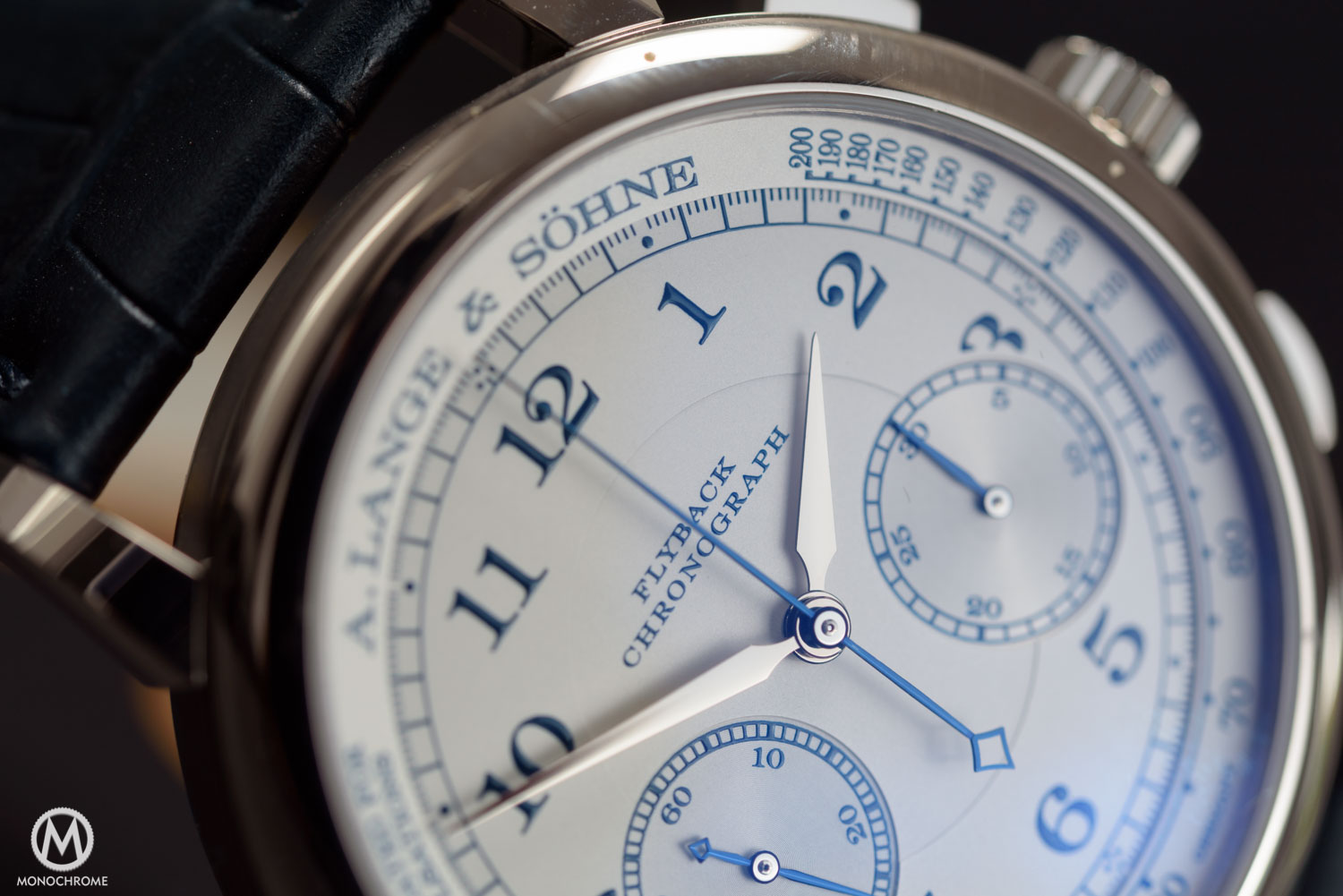



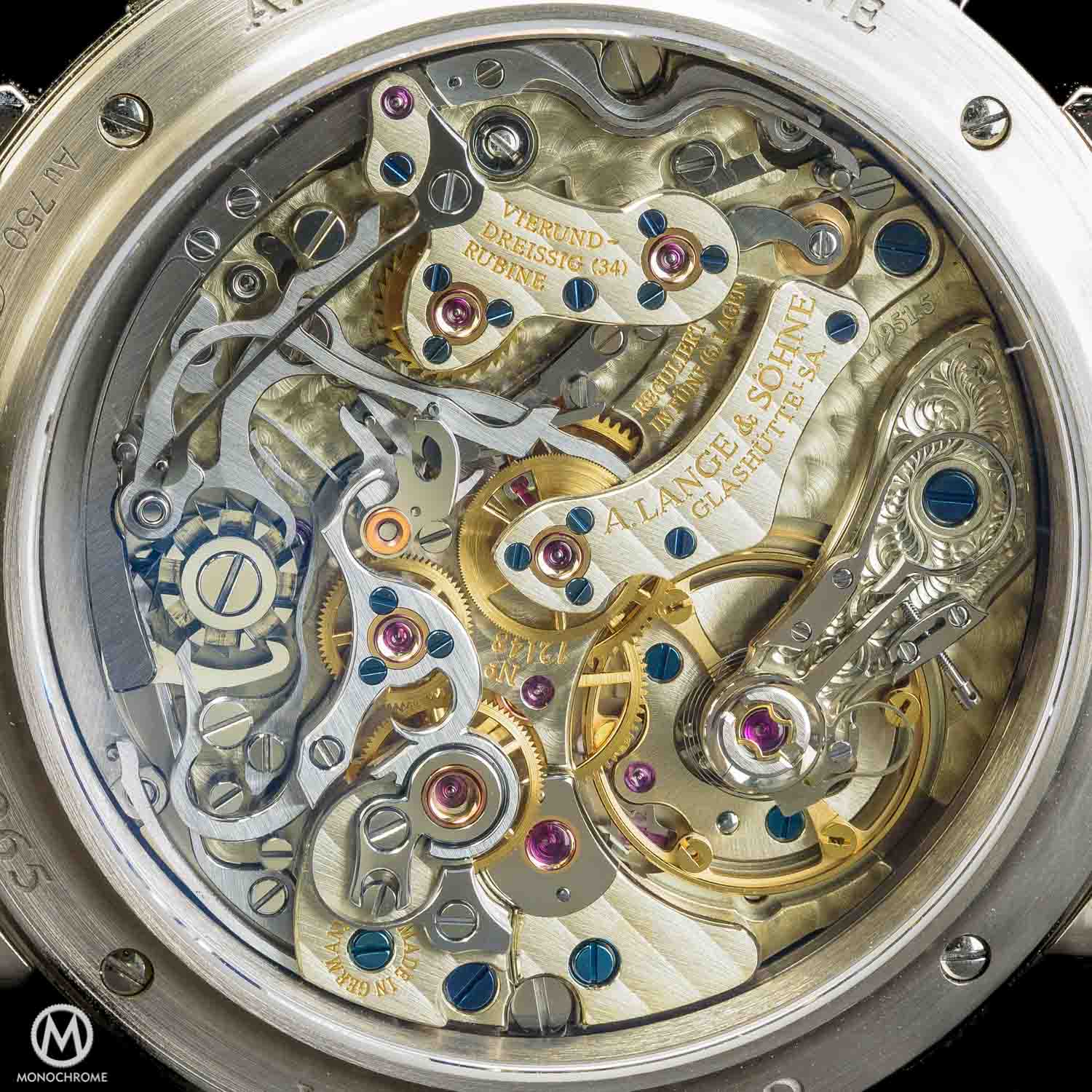
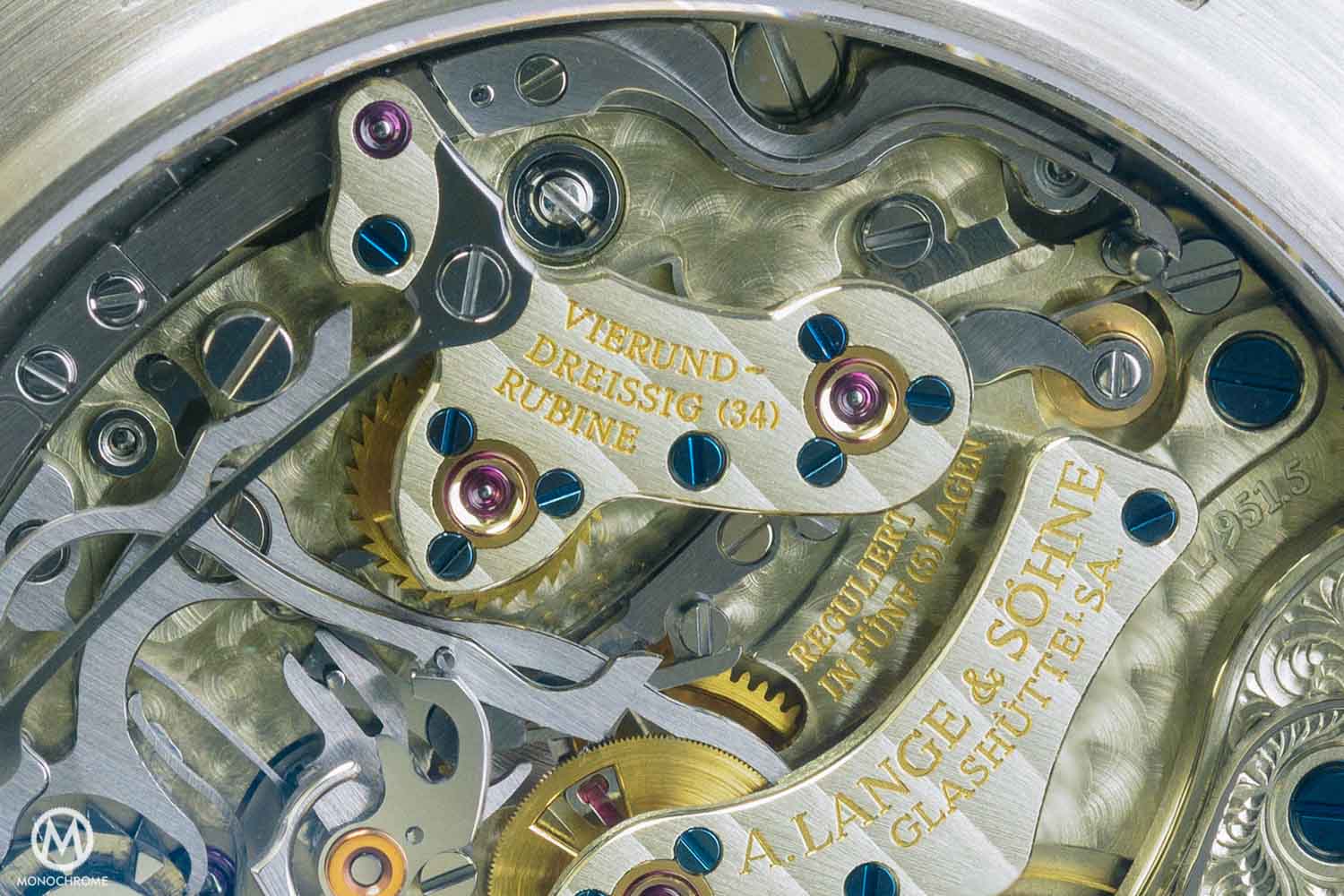


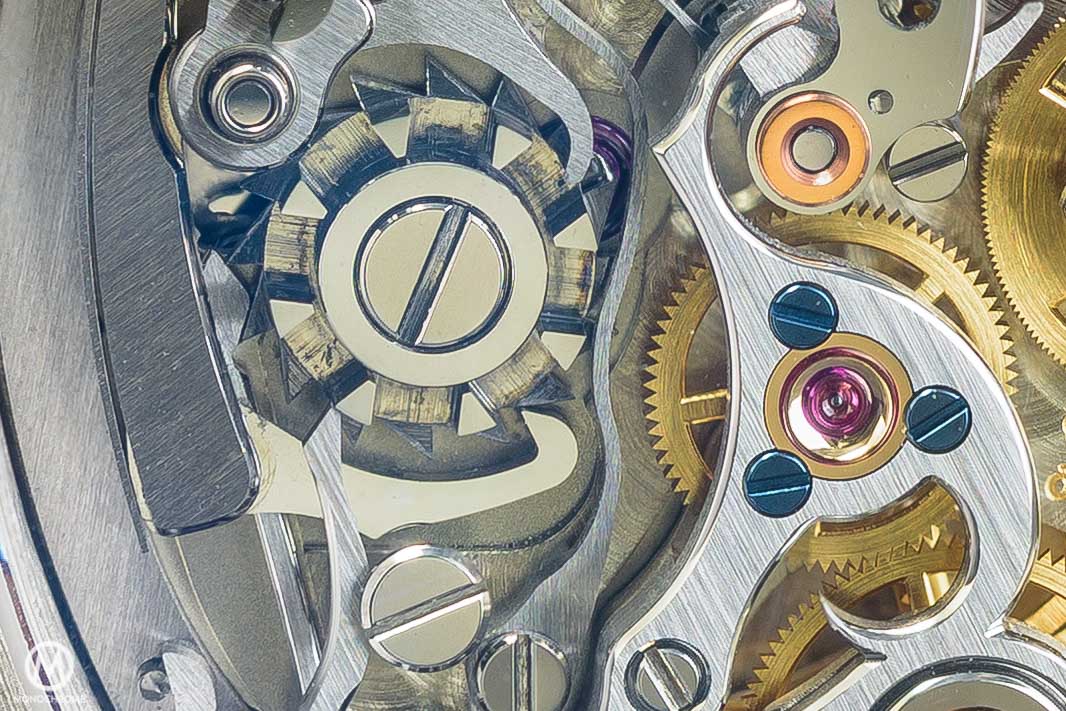













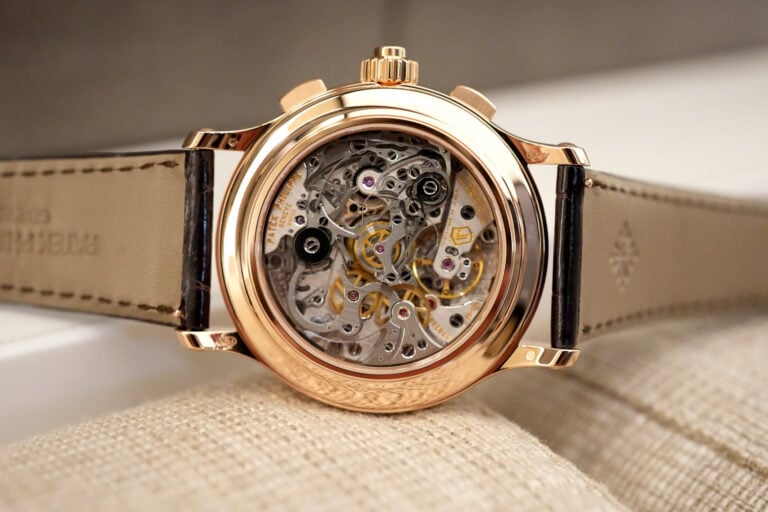
4 responses
Hi Peter, i think this is the best write up , by far, on a chronograph movement if have read in a long time, pictures and text integrated like a column wheel ! And a beautiful watch it is too. I sense a lot of the same quality as in Walt Odetts pieces and you have used the advantage of modern lay out techniques and better pictures to an optimum. So really really good and mandatory reading for newbies.
I have ask this before to Frank but if you get the chance to put it to ALS : a 2 register dial is the best i think, but why oh why always with running seconds ( you already have the large chrono hand) instead of a hour counter ?? much more practicle.
Tip top, and that is just the article.
As Frank said recently ,perhaps Lange & Sohne deserve more recognition as being an equal to the very best in the world.
Amazing article! As a 1815 Chrono owner I am amazed by complexity and design of this movement. Great job in breaking everything down!
Hi Peter,
thanks a lot for this article, it is along time I read about watches on the web and let me say this is one of the best articles ever on chronograph and how it works. Congratulations !
Concerning the Lange, what to say ? It is a true masterpiece by one of the (if not the) leading brands.
Regards,
slide68